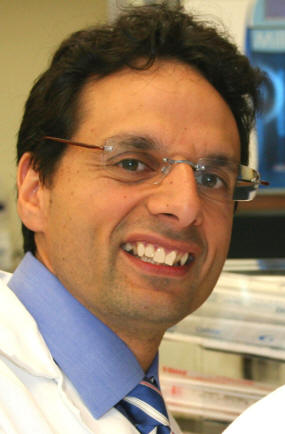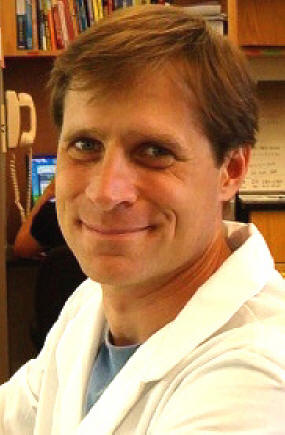Second 2011 Biomedical
Research Collaboration Award
Memphis, TN, October 15, 2011 --The Hartwell
Foundation announced its second
Biomedical
Research Collaboration Award in 2011, providing
funding to expand the frontiers of early-stage,
innovative and cutting-edge applied biomedical research
through special collaboration. It is the fifth such
award made by the foundation since 2008.
David Hackam, MD, Ph.D.,
2008 Hartwell Investigator and Professor of Surgery,
Physiology and Cell Biology at the University of
Pittsburgh, together with
John March, Ph.D., 2007
Hartwell Investigator and Associate Professor of
Biological and Environmental Engineering at Cornell
University, will receive $543,571 in direct costs over
three years to pursue their proposal for “Generation of
an Artificial Intestine for the Treatment of Short Bowel
Syndrome in Children.”
The clinical condition in which the body is unable to
absorb food after significant loss of the intestine is
called short bowel syndrome (SBS). While its true
incidence is unknown, in the United States the condition
affects over 5000 children, with an estimated 15,000
older patients requiring long-term home parenteral
nutrition. SBS can be caused by loss of large portions
of functioning intestine – such as occurs typically as a
consequence of necrotizing enterocolitis (NEC), Crohn's
disease, or as a result of a birth defect in which the
intestines do not develop normally. Because food cannot
be adequately absorbed by the shortened intestine,
nutrients must be administered directly into the
circulation through a vein. Although this approach can
supply adequate calories, children who receive nutrition
directly into the circulation commonly suffer from
intravenous catheter infections and severe liver
toxicity, with mortality around 30%. Only about one
third of patients with SBS can expect to be weaned from
parenteral nutrition. The majority of children with
short bowel syndrome require intestinal transplantation
and if toxicity from the administered nutrition is
severe enough, liver transplantation, as well. While the
outcome after intestinal transplantation is improving,
this procedure is limited by a lack of suitable donors
and complications from immunosuppressive therapy. To
address the difficulty of managing short bowel syndrome
in children, Hackam and March propose constructing an
artificial intestine using cultured intestinal stem
cells from the recipient’s intestine that can grow on a
synthetic 3-dimensional bioscaffold.
Based upon his discovery that expression and signaling
activity of a molecular “switch” called toll-like
receptor 4 (TLR4) was elevated in the intestine of human
infants with NEC and that mice lacking TLR4 were
protected from the development of NEC, Hackam
proposed as a 2008 Hartwell Investigator to identify
novel chemical compounds for the treatment of the
disorder. He deployed a strategy to identify specific
inhibitors of TLR4 signaling in the intestine utilizing
high throughput computer-aided screening of chemical
libraries, combined with whole animal screening. He
successfully identified 67 novel TLR4 inhibitors, with
one compound particularly effective in reducing the
severity of experimentally induced NEC in mice. He is
now focused on confirming the mechanism of action of the
compound, while performing chemical modification to
improve it as a powerful new treatment for the
management of NEC in neonates.
As a 2007Hartwell Investigator, March proposed to
engineer ordinary, consumer-grade commensal (probiotic)
bacteria that live in the human GI tract, to produce a
protein that would stimulate the epithelial cells that
line the intestine to secrete insulin into the blood
circulation. He reasoned that his approach would
effectively "hide" the insulin production site from the
autoantibodies that destroy insulin-producing β-cells in
type 1 diabetes. He successfully demonstrated with a
modified probiotic in experimentally-induced diabetic
mice clear reductions in blood glucose levels as well as
increases in blood insulin. He also demonstrated the
effectiveness of this approach in non-obese diabetic
mice. Implementation of his innovation for treating
type-1 diabetes would move the center of glucose
response from the pancreas to the gut, which could
result in a therapy that avoids repeated insulin
injections and might cost as little as $100 per year.
In their Collaboration, Hackam and March propose to
generate and optimize a novel bioscaffold to support the
growth and differentiation of intestinal stem cells;
optimizing cell growth conditions in a three-dimensional
“gut tube” reactor or artificial intestine. They will
subsequently implant the gut tube into mice with
surgically-created short bowel syndrome and perfuse the
intestine with a nutritional formula to assess the
ability of the host to absorb nutrients through the
artificial intestine. The collaborators will also
examine the safety and efficacy of implantation of the
artificial intestine in a pig model of short bowel
syndrome. The rationale for the use of pigs is that they
share greater similarity with humans and the larger
abdominal cavity in pigs will facilitate the scale up of
the artificial intestine to a size appropriate for
humans.
The Hackam-March collaboration brings together a
pediatric surgeon and clinical scientist specializing in
the intensive care of neonates with intestinal disorders
and a bioengineer familiar with the creation of
artificial tissue matrices. While Hackam had
successfully isolated and grown intestinal stem cells in
culture, he lacked an appropriate collaborator with
knowledge about construction of a suitable artificial
matrix that could be used to support cell growth for an
artificial intestine. By contrast, March had developed a
novel artificial matrix (bioscaffold) to construct what
he called a gut tube reactor, but lacked access to the
intestinal stem cells and the expertise in stem cell
biology required for it to become a functional
intestine.
"The generation of a novel matrix with the ability to
absorb nutrients while supporting the growth of
intestinal stem cells is highly complex, thus we will
use innovative statistical design of experiments
software for response surface optimization of the
bioscaffold, which will guide us in the development of
the artificial intestine," said Dr. March.
“John and I have already generated a structure that
bears remarkable similarity to the normal intestine,
providing a sense of excitement, conviction and hope
that we can overcome the overwhelming skepticism to
develop an artificial intestine – a novel translational
therapeutic for children with short bowel syndrome,”
related David Hackam.
“The generation of artificial organs represents an
absolute holy grail in medical research; a
transformative approach for children with short bowel
syndrome that could benefit thousands of children by
reducing morbidity and mortality,” said Frederick
Dombrose, President of The Hartwell Foundation.
Fostering collaboration between investigators of
complementary scientific strengths is a primary
objective of The Hartwell Foundation Mission to fund
innovative, early-stage applied biomedical research with
the potential to benefit children. |
|

2008 Hartwell Investigator
David Hackam, MD, Ph.D.,
University of Pittsburgh

2007 Hartwell Investigator
John March, Ph.D.,
Cornell University
Biomedical Research Collaboration Awards
Individual Biomedical
Research Awards
Top Ten Centers
HOME
|

